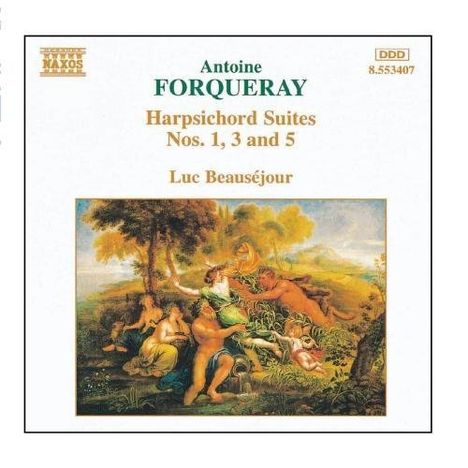Antoine Forqueray: Suiten für Cembalo Nr.1,3,5 auf CD
Suiten für Cembalo Nr.1,3,5
Herkömmliche CD, die mit allen CD-Playern und Computerlaufwerken, aber auch mit den meisten SACD- oder Multiplayern abspielbar ist.

- Künstler:
- Luc Beausejour, Cembalo
- Label:
- Naxos
- Aufnahmejahr ca.:
- 1994
- Artikelnummer:
- 7459940
- UPC/EAN:
- 0730099440721
- Erscheinungstermin:
- 26.6.1995
- Gesamtverkaufsrang: 12303
- Verkaufsrang in CDs: 5277
Antoine Forqueray soll über dreihundert Werke für sein Instrument, die Bassgambe, komponiert haben. Von diesen ist keines in Form eines autographen Manuskripts erhalten geblieben. Abgesehen von einer Handvoll Stücke in Sammlungen aus seiner Lebenszeit sind uns nur neunundzwanzig ihm zugeschriebene Werke überliefert, die von seinem Sohn Jean-Baptiste (1699 -1782), ebenfalls ein hervorragender Gambenspieler, zusammengestellt wurden. Diese Stücke, zu denen drei weitere von Jean-Baptiste komponierte hinzukommen (La Angrave, La Du Vaucel und La Morangis ou la Plissay), sind in fünf Suiten geordnet und wurden 1747 in zwei Bänden veröffentlicht: Pieces de viole avec la basse continue (zwei Gamben und Cembalo), und Pieces de viole mises en pieces de clavecin (eine Bearbeitung des ersteren für Solo-Cembalo).
Bei der Betrachtung dieser Sammlungen steht man vor zwei noch unbeantworteten Fragen. Sind die Werke wirklich von Antoine Forqueray? Ist Jean-Baptiste der wahre Autor der Cembalobearbeitungen, oder sind sie vielmehr das Werk seiner zweiten Frau, Marie-Rose Dubois, die offenbar eine versierte Cembalistin war? Wie dem auch sei, die häusliche Situation der Forquerays war von Prüfungen und Drangsalen genug geplagt, um Zweifel an Jean-Baptistes Motiven für die Veröffentlichung der Werke aufkommen zu lassen.
Die Cembalobearbeitungen der Gambenstücke behalten alle Qualitäten des Originals bei und führen äußerst fantasievolle Modifikationen ein, die sie zu einigen der raffiniertesten und kühnsten Werke des französischen Cembalororepertoires machen. Forqueray behält den tiefen Tonumfang der Stücke bei, "um ihren Charakter zu bewahren". Dies hätte es den französischen Instrumenten der damaligen Zeit, die sich auf ihrem Höhepunkt befanden, ermöglicht, prächtig zu klingen. Gleichzeitig bemühte er sich, die Cembalobassstimme so weit wie möglich zu verzieren, indem er sie mit idiomatischen, virtuosen Passagen ausfüllte. Was für die Gambe virtuos war, bleibt daher auch für das Cembalo, wie die letzte Strophe des Rondeaus mit dem Titel Jupiter zeigt.
Product Information
Antoine Forqueray is said to have composed over three hundred works for his instrument, the bass viol. Of these, none has survived in autograph manuscript form. Apart from a handful of pieces in collections dating from his lifetime, only twenty-nine works attributed to him have come down to us, compiled by his son Jean-Baptiste (1699 -1782), he too an excellent viol-player. These pieces, to which are added three others composed by Jean-Baptiste (La Angrave, La Du Vaucel, and La Morangis ou la Plissay), are ordered in five Suites and were published in 1747 in two volumes :Pieces de viole avec la basse continue (two viols and harpsichord), and Pieces de viole mises en pieces de clavecin (an arrangement of the former for solo harpsichord).
When considering these collections, one is faced with two as yet unanswered questions. Are the works really by Antoine Forqueray? Is Jean-Baptiste the true author of the harpsichord arrangements, or are they rather the work of his second wife, Marie-Rose Dubois, who was apparently an accomplished harpsichordist? Be that as it may, the Forquerays' domestic situation was sufficiently afflicted by trial and tribulation as to cast some doubt over Jean- Baptiste's motives for publishing the works.
The harpsichord arrangements of the viol pieces retain all the qualities of the original, whi1e introducing highly imaginative modifications which make them into some of the most refined and audacious works of the French harpsichord repertoire. Forqueray maintains the low range of the pieces "to preserve their Character". This would have allowed the French instruments of the time, which were at their zenith, to resound magnificently. At the same time, he strove to ornament the harpsichord bass part as much as possible, by filling it in with idiomatic virtuoso passages. Hence, what was virtuosic for the viol remains so for the harpsichord, as is exemplified by the last verse of the rondeau titled Jupiter.
Disk 1 von 1 (CD)
-
1 Harpsichord Suite No. 1 in D minor: I. La Forqueray
-
2 Harpsichord Suite No. 1 in D minor: II. La Cottin
-
3 Harpsichord Suite No. 1 In D Minor: Iii. La Bellmont
-
4 Harpsichord Suite No. 1 in D minor: IV. La Portugaise
-
5 Harpsichord Suite No. 1 in D minor: V. La Couperin
-
6 Harpsichord Suite No. 3 in D major: I. La Ferrand
-
7 Harpsichord Suite No. 3 in D major: II. La Regente
-
8 Harpsichord Suite No. 3 In D Major: Iii. La Tronchin
-
9 Harpsichord Suite No. 3 in D major: IV. La Angrave (by Jean-Baptiste Forqueray)
-
10 Harpsichord Suite No. 3 in D major: V. La Du Vaucel (by Jean-Baptiste Forqueray
-
11 Harpsichord Suite No. 3 in D major: VI. La Eynaud
-
12 Harpsichord Suite No. 4 in G minor: I. La Boisson
-
13 Harpsichord Suite No. 4 in G minor: II. La Montigni
-
14 Harpsichord Suite No. 4 In G Minor: Iii. La Sylva
-
15 Harpsichord Suite No. 4 in G minor: IV. Jupiter
Mehr von Antoine Forqueray
-
Jose Miguel Moreno - Theorbes francaisesCDAktueller Preis: EUR 9,99
-
Antoine ForquerayPieces de Viole (Suite Nr.3)CDAktueller Preis: EUR 7,99
-
Antoine ForquerayPieces de Viole mit Bc (Gesamtaufnahme)2 CDsAktueller Preis: EUR 14,99
-
Antoine ForquerayPieces de Clavecin2 CDsAktueller Preis: EUR 9,99






